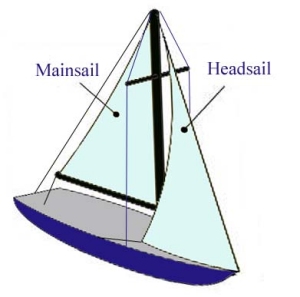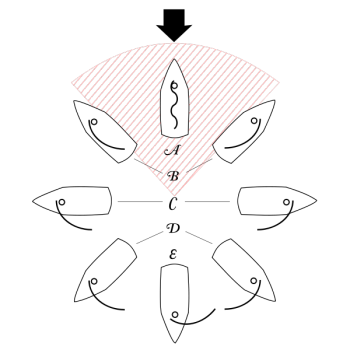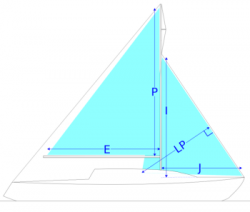Sails
From CruisersWiki
m (Text replace - "{|id="mp-right" width="100%" cellpadding="2" cellspacing="1" style="vertical-align:top; background:#f5faff; border:1px solid #a3b0bf;" ! <h2 id="mp-itn-h2" style="margin:0; background:#cedff2; font-size:120%; font-weight:bold; border:1px s) |
m (Text replace - "]] | |} ." to "]] | |} [[Category:<insert here>]] ") |
||
| Line 86: | Line 86: | ||
| - | + | [[Category:<insert here>]] | |
| + | |||
[[Category:The Yacht]] | [[Category:The Yacht]] | ||
Revision as of 19:07, 7 June 2011
Contents |
Cruising Yacht's Sails
Introduction to Yacht's Sails
The most common sail plan for cruising yachts is the Sloop. This has two sails in a fore-and-aft arrangement: the mainsail and the jib.
The mainsail extends aftward and is secured the whole length of its edges to the mast and to a boom also hung from the mast.
The jib is secured along its leading edge to a forestay strung from the top of the mast to the bowsprit on the bow of the boat. A genoa is also used on many cruising yachts - it is a type of jib that is large enough to overlap the mainsail, and cut so that it is fuller than an ordinary jib.
Fore-and-aft sails can be switched from one side of the boat to the other in order to provide propulsion as the sailboat changes direction relative to the wind. When the boat's stern crosses the wind it is called gybing and when the bow crosses the wind, it is called tacking. Tacking repeatedly from port to starboard and/or vice versa, called "beating", is done in order to allow the boat to follow a course into the the wind.
A primary feature of a properly designed sail is an amount of draft, caused by the curvature of the surface of the sail. When the leading edge of a sail is oriented into the wind, the correct curvature helps maximise lift while minimising turbulence and drag, much like the carefully designed curves of aircraft wings. Modern sails are manufactured with a combination of broadseaming and non-stretch fabric. The former adds draft, while the latter allows the sail to keep a constant shape as the wind pressure increases. The draft of the sail can be reduced in stronger winds by use of a cunningham and outhaul, and also by bending the mast and increasing the downward pressure of the boom by use of a boom vang.
Aerodynamics of Sails
Sails propel the boat in one of two ways:
- When the boat is going in the direction of the wind (i.e. downwind), the sails may be set merely to trap the air as it flows by. Sails acting in this way are aerodynamically stalled. In stronger winds, turbulence created behind stalled sails can lead to aerodynamic instability, which in turn can manifest as increased downwind rolling of the boat. Spinnakers and square-rigged sails are often trimmed so that their upper edges become leading edges and they operate as airfoils again, but with airflow directed more or less vertically downwards. This mode of trim also provides the boat with some actual lift and may reduce both wetted area and the risk of "digging in" to waves.
- The other way sails propel the boat occurs when the boat is traveling across or into the wind. In these situations, the sails propel the boat by redirecting the wind coming in from the side towards the rear. In accordance with the law of conservation of momentum, air is redirected backwards, making the boat go forward. This driving force is called lift although it acts largely horizontally.
On a sailing boat, a keel or centreboard helps to prevent the boat from moving sideways. The shape of the keel has a much smaller cross section in the fore and aft axis and a much larger cross section on the athwart axis (across the beam of the boat). The resistance to motion along the smallest cross section is low while resistance to motion across the large cross section is high, so the boat moves forward rather than sideways. In other words it is easier for the sail to push the boat forward rather than sideways. However, there is always a small amount of sideways motion, or "leeway".
Forces across the boat are resolved by balancing the sideways force from the sail with the sideways resistance of the keel or centerboard. Also, if the boat heels, there are restoring forces due to the shape of the hull and the mass of the ballast in the keel being raised against gravity. Forward forces are balanced by velocity through the water and friction between the hull, keel and the water.
Sail Parts
The lower edge of a triangular sail is called the foot of the sail, while the upper point is known as the head. The lower two points of the sail, on either end of the foot, are called the tack (forward) and clew (aft). The forward edge of the sail is called the luff (from which derives the term luffing, a rippling of the sail when the angle of the wind fails to maintain a good aerodynamic shape near the luff). The aft edge of a sail is called the leech.
Modern sails are designed such that the warp and the weft of the sailcloth are oriented parallel to the luff and foot of the sail. This places the most stretchable axis of the cloth along the diagonal axis (parallel to the leech), and makes it possible for sailors to reduce the draft of the sail by tensioning the sail, mast and boom in various ways.
Often tell-tales (small pieces of yarn), are attached to the sail that are used as a guide when trimming the sail.
Sail Types
Modern sails can be classified into three main categories and "special-purpose" sails are often a variation of the three main categories.: Mainsail, Headsail, Spinnaker or downwind sail (also known as a Kite).
Most modern cruising yachts including bermuda rig, ketch and yawl boats have a sail "inventory" which usually includes more than one of these types of sails. Although the mainsail is “permanently” hoisted while sailing, headsails and spinnakers can be changed depending on the particular weather conditions to allow better handling and speed.
- Mainsails, as the name implies, are the main element of the sailplan. A "motor" as well as a "rudder" for the boat, mainsails can be as simple as a traditional triangle-shaped, cross-cut sail. In most cases, the mainsail isn’t changed while sailing although there are mechanisms to reduce its surface if the wind is very strong (reefing). In extreme weather, a mainsail can be folded and a trysail hoisted to allow steerage without endangering the boat.
- Headsails are the main driving sails when going upwind. There are many types of headsails with the Genoa and Jib being the most commonly used. Both these types have different subtypes depending on their intended use. Headsails are usually classified according to their weight (the relative weight of the sailcloth used) and size or total area of the sail. A common classification is numbering from 1 to 3 (larger to smaller) with a description of the use for example: #1 Heavy or #1 Medium/Light. Special types of headsails include the Gennaker (also named Code 0 by some sailmakers), the Drifter (a type of Genoa that is used like an asymmetrical spinnaker), the Screecher (essentially a large Genoa), the Windseeker and the Storm jib. Certain Genoas and Jibs also have battens which assist in maintaining an optimal shape for the sail.
- Spinnakers are used for reaching and running (downwind sailing). They are very light and have a balloon-like shape. As with headsails there are many types of spinnakers depending on the shape, area and cloth weight. Symmetrical spinnakers are most efficient on runs and dead runs (sailing with wind coming directly from behind) while asymmetric spinnakers are very efficient in reaching (the wind coming from the rear but at an angle to the boat or from the side).
Measurement
Every sail-plan has maximum dimensions. These maxima are for the largest sail possible and they are defined by the image's (right) letter abbreviation.
- J The base of the foretriangle measured along the deck from the forestay pin to the front of the Mast.
- I The height measured along the front of mast from the jib halyard to the deck.
- E The foot length of the mainsail along the boom.
- P The luff length of the mainsail measured along the aft of the mast from the top of the boom to the highest point that the mainsail can be hoisted at the top of the mast.
- Ey The length of a second boom (For a Ketch or Yawl).
- Py The height of the second mast from the boom to the top of the mast.
Fitting
Details?
Maintenance
- Cleaning Sails - We clean our sails at least once a year, bringing them ashore where they can be laid out. We do it early in the morning on a sunny day. Using a relatively soft brush (so we don't damage the sail cloth or the stitching) we use regular liquid laundry detergent, then hose off.
We check over the sail first, to determine if there are any bad stains. Rust stains (which will destroy your sail really quickly) we remove by putting either oxalic acid or hydrofluoric acid (the latter is found in commercial rust removers) onto the stain, watching it work and rinsing it off thoroughly with the hose immediately. CAUTION: both the above acids do more damage to the tissues and nerves than to the skin, so it's a silent and nasty poison that does its damage before you realize there's anything wrong. Do wear rubber gloves and be careful. That said, I think that both acids are extremely useful on a boat, so we always have a supply. We just are careful using them. DuPont recommends a mild solution of chlorine bleach to remove mildew stains from dacron sails (but never, never use chlorine bleach on nylon). We usually use liquid non-chlorine bleach (such as Clorox 2(tm)), full strength on the stain before washing the entire sail. We then haul the sail up, on whatever line we can rig, for it to dry completely before we put it back on the boat. If you fold your sail up before it's completely dry, you run the risk of mildew forming, particularly if you then stow them in a locker. Cleaning the sails this way gets us up close and personal with the sails, so we check over all the stitching while we're working. Broken stitches means we take it to be repaired right away before things go wrong.
Also see: Sail Care
Also See
|
|---|
|
Names: |
| |
|---|
| | HOMEPAGE | Wiki Contents | Sails | |
[[Category:<insert here>]]


